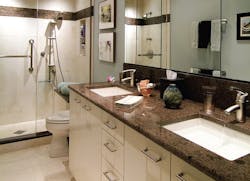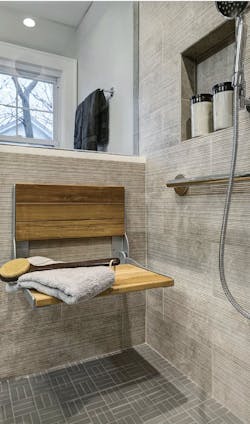It’s no secret that the nation’s population is aging, but the statistics are impressive: Roughly 54.1 million Americans are age 65 or older, according to the U.S. Department of Health and Human Services. That’s 16% of the population, and by 2040, it’s projected to be more than 21% — one-in-five.
In a survey conducted by the AARP late last year, 77% of adults 50 and older said they want to remain in their homes for the long term. The housing desires of this key demographic are an important aspect of the residential construction market, and this large, aging population that wants to stay in their homes will drive strong demand for aging-in-place specialists for decades to come.
How does a remodeler make a good living while meeting the needs of this market? Two seasoned professionals, Michael Menn of Chicago, and Curt Kiriu of Mililani, Hawaii, offered their ideas about the keys to success. They serve very different markets but see the basics in the same light.
Know CAPS and Your Customer
It is critical to “truly understanding aging-in-place and universal design,” said Menn, principal of Michael Menn, Ltd. “The clients are getting smarter and smarter.”
Menn, who is a remodeler and an architect, was part of the “beta” CAPS, or Certified Aging-in-Place Specialist, class more than 30 years ago.
He exhorts remodelers to know their markets. “Not everybody can afford everything,” he said. “Maybe it’s installing a grab bar. Maybe it’s a whole house renovation, or something in between.”
Listening to a customer’s needs and making sure you have a sense of their budget is crucial, he added.
“Know who you’re talking to,” said Menn. “Understand whether you’re talking to an end user, to a caregiver or to their children. All three have different priorities and different interests.”
When you meet with the homeowner, they may not tell you everything about their physical capabilities and limitations. So, you have to be observant for signs, in and around their home.
Menn has done several multi-generational homes over the last 20 years. It’s different from standard aging-in-place projects, he says, because the remodeler needs to address the needs of different age groups. Universal design, he says, can be key.
“We’re seeing more and more multi-generation living environments now,” Menn said. “And universal design can help you span the three generations — the parents, their children and the grandchildren.”
An example: He and his team were working on a bathroom project and wanted to add a toe-kick light. They also added a motion sensor so the resident would automatically have soft light when they visit the bathroom at night. The home owner now loves that feature.
Passion and Trust
“You have to be passionate about this specialized market,” said Kiriu, of CK Independent Living Builders. “I’m up about 4 a.m. every morning because I’m thinking about the project and home owners I am working with — who do I have to connect with, what does the homeowner need? So I get out of bed and get to work.”
Kiriu said a perceptive eye can help deliver a final product that allows the home owner to address challenges they did not even recognize. “When you meet with the homeowner, they may not tell you everything about their physical capabilities and limitations,” he said. “So, you have to be observant for signs, in and around their home.”
For example, he said any place you see wear or rub marks on the walls and door jambs shows you where members of the household put their hands to support themselves when moving through their home.
There are many aging-in-place modifications that may seem routine to the CAPS professional, but taken together can be eye-opening — even life changing — for the homeowner. Kiriu listed a few changes that can make activities of daily living easier for the resident.
“We’re just finishing up a home modification where we are using sliding doors — barn doors,” he said. “We’ve included soft-close mechanisms that make it easier to open and close without slamming doors and smashing fingers.”
Other popular modifications include:
-
Wall switches with an LED nightlight, so the resident can find the switch in the dark.
-
Curbless showers that make it possible for the user to just walk in and not step in/out of a bathtub.
-
Pull-down shelving in upper wall cabinets, so the user doesn’t have to use a step stool, which reduces the risks of falling.
-
Pull-out hardware for blind corners of kitchens.
-
LED-integrated light fixtures that don’t require changing of bulbs.
That’s just scratching the surface of potential modifications and amenities.
Key to the process is building trust with the homeowner from the earliest interactions. Kiriu believes it is important to be on time, dress professionally, know your subject and work on your communication skills.
“Most homeowners have never heard the terms ‘universal design’ or ‘aging-in-place’, so I address each meeting or interaction as a wonderful opportunity to educate them as best I can,” Kiriu said. “Once they understand what these terms mean, and the overall long-term benefits to improve their current and future lifestyle, they are more open to a home modification — rather than a typical remodel — utilizing aging-in-place and universal design methods, designs, materials and products.”

